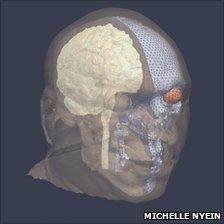Visor could reduce head injuries caused by explosions
- Published

A simple face shield added to soldiers' helmets could save lives, says a study.
A detailed simulation of how explosive blasts pass through the skull shows existing helmets used by the US delay but do not dissipate blast waves.
Writing in Proceedings of the National Academy of Sciences, researchers say that blasts' pressure waves enter the skull primarily through the face.
A clear plastic shield could spread that pressure throughout the helmet, avoiding brain injury, they say.
Previous studies have suggested that the Advanced Combat Helmet, currently employed by the majority of US ground troops in Iraq and Afghanistan, actually focuses blast wave energy, causing more harm than good.
To find out, Raul Radovitzky of the Massachusetts Institute of Technology's Institute for Soldier Nanotechnologies and his colleagues simulated a human skull in detail on a computer.
They then applied a simulated blast wave to it, observing how the pressure wave - an advancing, expanding sphere representing 10 times normal atmospheric pressure - propagated through a simulated head with and without a helmet on.
The team found that the current helmet does not make matters worse.
"The existing Advanced Combat Helmet... does not worsen the negative effects of a blast wave - does not enhance the energy of the blast - as has been previously suggested," Dr Radovitzky told BBC News.
"But we also find that it doesn't really help much; it doesn't mitigate the blast wave significantly."
Face value
The reason for that appears to be that the helmet does not cover the part of the skull most vulnerable to a pressure wave.
"Our simulations without the helmet and with it both show that the primary pathway for transmission of the energy of the blast into the brain tisssue is through the soft tissues of the face," Dr Radovitzky explained.
The team added a face shield to their simulation - similar to the plain plastic visors used in motorcycle helmets - and found they radically changed the degree to which explosive energy was transmitted to the brain.
However, Dr Radovitzky, whose team is in consultations with the US Army on soldier technology, said that there are many factors to take into consideration when suggesting changes to standard-issue kit for soldiers.
"There are of course many other aspects of putting a face shield on a soldier's helmet that need to be taken into acount, like how you would affect the situational awareness of the soldier, how they can operate without being hindered by the device."
- Published7 November 2010
- Published14 June 2010